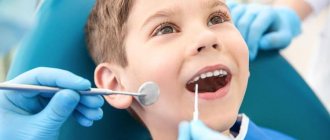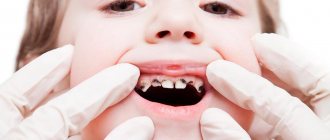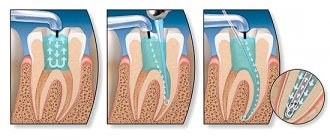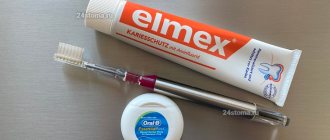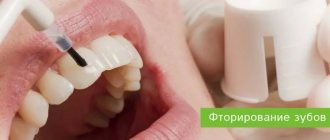Tooth enamel is one of the strongest tissues in the human body. However, the margin of safety given to us by nature is not always sufficient. Enamel is destroyed under the influence of external factors (cold and hot foods, whitening procedures), as well as from a lack of fluoride, calcium and phosphorus. One of the ways to restore it is to coat the teeth with fluoride varnish. Below we will tell you in what cases and how this procedure is carried out and what its effect on tooth enamel is.
Prices
| Deep fluoridation (one tooth) | 250 rub. |
Fluoridation: strengthening and protecting teeth
Since childhood, we have all been told that we need to eat less sweets and more fresh fruits, vegetables and dairy products. And why all? They contain useful vitamins and minerals that support the health of the body, give energy and strength. Our teeth also need additional nutrition. When teeth are strong from the inside, they are better able to withstand external influences, which means that the risk of caries is reduced significantly. How to strengthen and restore tooth enamel? What is fluoridation and why is fluoride varnish needed?
Modern methods of treating dental caries
In our dentistry, caries treatment is carried out using the latest methods. The priority issues of modern therapy are restoration of aesthetics, functional state of the unit, prevention of migration of inflammation to pulp tissue:
Treatment of caries without the use of a drill
:
- infiltration
_ Treatment of caries without drilling is practiced at the initial stage and involves chemical-mechanical treatment. A special gel is applied to the working area of the tooth to break down the enamel. The bacterial focus is dried under the influence of a stream of air and ethyl alcohol, and treated with polymer resin. Advantages of caries treatment without drilling: non-invasiveness, atraumaticity, speed of therapy, preservation of the unit’s shape, restoration of fluorescence in 80% of cases. Correction of pigmented spots allows you to stop the demineralization process and save the tooth; - air abrasive polishing
. The surface defect is “knocked out” by an intense flow of abrasive ingredients, while only areas affected by microorganisms are affected. In terms of efficiency, the method is comparable to using a drill and drilling, does not require freezing, and minimizes the risk of microcracks; - ART method
. Restorative therapy, which involves high-quality removal of pathology followed by filling the affected area with dental cement without the use of special equipment; - laser correction
. Used to eliminate the focus of caries through fluorescence. The laser acts precisely on the problem area, “evaporates” it, and at the same time disinfects the resulting space, which minimizes the likelihood of relapse; - remineralization
_ Turnkey treatment of caries is carried out according to the following scheme: professional sanitation of the oral cavity - selection of individual hygiene products - remineralizing therapy using a solution of calcium gluconate, fluoride-containing drugs. After completing the course, there is a stabilization of the balance of minerals in the oral cavity and an increase in the stability of the enamel.
Treatment of caries using preparation
In advanced cases, non-invasive methods of medical intervention, for example, treatment of caries without drilling, do not produce results, so doctors practice mechanical cleaning (preparation) of the deformed area. When dentin is damaged, infected tissue and pulp are removed.
Modern specialized devices allow you to perform all manipulations quickly, painlessly, and as comfortably as possible for the patient. After preparation, a filling or restoration is installed.
Stages of invasive treatment of advanced caries:
- preparation: cleaning from plaque using special tools, selecting the shade of the filling material;
- local/general anesthesia;
- preparation;
- medicinal treatment with a solution of cobalt chloride, application of a paste containing calcium hydroxide;
- installation with a calcium-containing gasket. Has a bactericidal and remineralizing effect, promotes tightness;
- placing a filling with regeneration of the tooth shape;
- polishing, grinding the filling.
What is dental fluoridation?
This is a procedure for strengthening enamel, during which a specialist applies a preparation containing useful microelements to the teeth, the main of which are fluoride and calcium.
The special composition penetrates deep into the enamel, fills the pores, thereby restoring and strengthening its structure. A protective barrier against bacteria is formed on the teeth. Why is it important to have fluoridation done by a dentist? The fact is that the procedure is especially effective when the enamel is clean and polished. Often, strengthening teeth is the final stage of professional oral hygiene. The specialist first carries out ultrasonic and abrasive cleaning of stone and plaque, and then saturates the enamel with minerals. This way it better absorbs all the useful components.
Diagnostics
It is carried out by examination (percussion, probing, determining the mobility of organs), collecting an anamnesis, additional methods of examination:
- radiography
. Allows you to visualize defects of the approximal surfaces, obtain a clear picture of the marginal segments of the alveolar processes of the jaws; - EDI
. Electroodontodiagnosis helps to differentiate the types of disease and determine its complications; - laser fluorescence
. The technology reveals structural changes during demineralization on the occlusal planes; - light fluorescence
. The technique in dentistry is designed for early detection of a lesion, determining its size, depth, and location.
There is no ideal diagnostic technique today; an integrated approach to making a diagnosis is required. A qualified dentist will always suggest that the patient undergo several additional examinations in order to analyze the current situation and prescribe an effective therapeutic regimen for the treatment of caries.
Fluoridation of teeth for children: benefit or harm?
The child’s baby teeth are not yet strong: they have fragile enamel, followed by a thin dentin layer, and at the base there is a soft pulp chamber with nerve endings and blood vessels. Therefore, children's teeth are more easily damaged; caries often forms on them, which can quickly develop into complications. It seems like just yesterday there was a small dark spot on the enamel, and today your child is complaining of severe toothache and refuses to eat.
To reduce the risk of tooth decay, baby teeth need to be cleaned regularly and properly, and strengthened. How can you help your children maintain a beautiful smile and protect them from toothache? With the appearance of the first teeth, bring your child to the dentist for a preventive examination 2-3 times a year. The pediatric dentist will promptly identify possible problems, teach in a playful manner the correct technique for brushing teeth, and also carry out fluoridation that is beneficial for the enamel.
Classification and symptoms
The clinic is diverse and is determined by the topography and depth of the affected segment. A sign of an early stage of carious lesions of the anterior and lateral teeth is a change in the shade of the enamel in an isolated area, the formation of a dark spot, subsequently a pathological cavity appears, and dentin is destroyed.
As it progresses, sensitivity to external mechanical/temperature stimuli, discomfort when eating, and disturbances in chewing function occur:
- initial caries
. Demineralization begins with the loss of the natural shine of the enamel, the formation of brown spots that extend into the surface segment. Caries penetrates the enamel and destroys it. In acute cases, symptoms such as increased sensitivity to thermal/chemical effects are noted; - superficial/medium caries
. It develops as a result of destruction of enamel at the site of the pigmented area, causing episodic pain from sour, sweet, and cold foods. Upon examination, a tooth lesion located in the enamel zone is diagnosed; with an average lesion, hard tissue is involved in the process; - deep caries
. Significant changes in dentin are recorded, accompanied by aching pain; - complicated caries.
It progresses to periodontitis, pulpitis, and damage to the nerve and root canals occurs.
Other types of caries classification:
- occlusive.
The appearance of such signs as damage to the chewing surface of the units. This group also includes fissure caries; - contact (approximal).
Develops in the interdental space; - cervical (cervical).
It is characterized by damage to the neck of the tooth - the area near the gum between the crown and the root hidden in the bone; - root.
Localized deep under the gum.
Depending on the rate of progression and characteristics of the course, chronic and acute inflammation are distinguished. Acute caries is characterized by rapid onset of lesions, intense pain, and severe discomfort from external irritants. The chronic course of the disease is characterized by slow damage to units and occurs in 5-7% of cases.
Simple fluoridation of teeth
The most common way to strengthen teeth. It is used to prevent caries. A special composition is applied to the enamel, which forms a thin protective film. What kind of composition is this? Fluoride varnish, fluorine-containing varnish, fluoride varnish or simply enamel restoration varnish - the strengthening agent has several names, but the result is the same. Your teeth are reliably protected, and the effect lasts up to six months.
Indications for applying fluoride varnish
The range of indications for coating teeth with varnish is quite wide and includes many points. Therefore, almost everyone can use fluoride varnish. Most often, the procedure is performed in the following cases:
- with increased tooth sensitivity,
- for the prevention of caries,
- if there are areas of demineralization on the enamel,
- after ultrasonic teeth cleaning,
- before installing crowns,
- in case of injury.
This procedure has virtually no contraindications. These include only increased sensitivity to components and an excess of fluoride in the body. Teeth can be coated with fluoride varnish as early as 6 years of age. Allergic reactions to the composition of the varnish are extremely rare.
Deep fluoridation of teeth
This is a more effective way to strengthen enamel.
For deep fluoridation, a more saturated fluorogel is used. It acts not only on the surface of the teeth, but also penetrates into the deep layers of enamel. Useful microelements, as a building material, restore the structure of the tooth, preventing the development of initial caries. The strengthening effect lasts up to a year. Fluoridation of teeth has a positive effect in most cases.
But before carrying out the procedure, you must consult a specialist. Oversaturation of enamel with fluoride, as well as its lack, are equally harmful to health. Do you want your teeth to be strong? Take care of them. Take just one day out of your busy schedule and visit the dentist. Fluoridation will strengthen the enamel for a long time and protect teeth from caries.
Commenting system SigComments
Back to section
How is caries treated with laser?
Laser treatment of caries is a modern non-contact method. The laser beam passes into the dental tissue to the depth required for treatment. It removes affected tissue, disinfects, and reduces the likelihood of bleeding. At the same time, the laser does not damage healthy tissue.
The advantages of laser treatment of dental caries are the minimal risk of complications, the ability to control the intensity and depth of the effect. With all its advantages, the laser is effective in the early stages of caries, like other non-invasive methods.
We recommend that you read
Dental treatment during pregnancy
Treatment of anterior teeth
Dental filling
Canal filling
Treatment in dentistry
After an examination, the doctor determines how to treat the carious situation. Therapy depends on the stage of the disease and the presence of complications: pulpitis, periodontitis. At the spot stage, treatment is not always necessary; preventive measures can be used. If other uncomplicated forms of the disease are detected, the carious cavity is thoroughly cleaned and a filling is installed. Deep lesions can be treated in several stages with the installation of first a temporary filling, then a permanent one.
The features of treatment for children and adults in our clinic may differ slightly and include a different set of services.
Oral hygiene
Individual hygiene procedures are exogenous methods of prevention. It is imperative to monitor the quality and condition of the brushes, follow the correct cleaning technique and do it regularly. It is advisable to use rinses, irrigators and dental floss as additional care methods.
Pastes for caries prevention
At home, you can use compounds that have therapeutic and preventive effects. When used daily, they compact the enamel, remove soft plaque and prevent the growth of harmful bacteria.
Fluorinated
Such pastes contain active amino fluoride. The action of this component is based on the natural mechanisms of fluoride, which is independently integrated into the enamel layer and prevents the leaching of calcium. Using these cleansers twice a day reduces the likelihood of developing the disease by 50%.
Without its content
Drinking water contains a certain amount of fluoride. If the indicators are within normal limits, then the enamel is independently saturated with this mineral. To maintain health, 1.2 mg/l is enough. In such situations, fluoride-free toothpastes are used to prevent dental caries in adults. They contain large amounts of calcium and also have an antibacterial effect. Used for everyday hygiene 2 times a day.
Dental floss
Unlike other products, it is able to remove food debris in the interdental spaces. These areas are inaccessible to brushes, so this is where problems most often arise. Fibers of synthetic or natural origin are used for manufacturing. To achieve maximum effect, the thread is impregnated with special solutions containing fluorides or antimicrobial components. It is advisable to use it after every snack or at least in the evening before brushing your teeth.
Mouth rinses
To further strengthen the protection, fluoride-based solutions are used at home, which have an anti-caries effect. They neutralize the aggressive effects of acid, which destroys enamel, and also prevent the proliferation of pathogens. Experts recommend rinsing your mouth with these products after each meal, as well as before bed.
Toothpicks
These devices are not an effective measure. They are used as an alternative when you don't have a brush or floss to hand to get rid of food stuck between your teeth. Doctors recommend giving preference to plastic or wooden products. Toothpicks must have a smooth surface without chips or cracks. Make sure that the end is slightly rounded, otherwise you may damage your gums.
First symptoms of the disease
Microorganisms that attack tooth enamel gradually destroy its structure.
A small damage gradually grows, turning into a large carious cavity. In the absence of timely treatment, the tooth tissue is destroyed, which can lead to its complete loss. To understand how to remove caries from teeth while maintaining their integrity, you should first become familiar with its symptoms. To independently determine the onset of the pathological process, you need to pay attention to the appearance of the teeth, increased sensitivity or any other unpleasant sensations.
Symptoms of caries include a change in the color of the enamel - its darkening, the appearance of stripes and furrows, spots and hard chalky formations. In addition, the development of this dental problem is indicated by sensitivity to sweets, cold and hot. Painful sensations during meals or for no reason at all, the appearance of bad breath - all this can also confirm the initial or more complex stage of caries.
Materials and anesthesia
In the past, silicate cements and amalgam were often used to treat caries. They were distinguished by high solubility and low hardness, but now these products are not used. In modern dentistry, in the natural treatment of caries, composite materials and light/chemically cured ionomer cements are used, which have excellent aesthetics, fixation, and strength, guaranteeing reliable filling.
Anesthesia during dental procedures can reduce the patient’s fear, eliminate pain, reduce the risk of complications, and make the dentist’s work easier. The choice of anesthetic is determined by the allergic/somatic status of the patient. Different types of anesthesia are used: general, local, combined.
Typically, injection anesthesia is performed with solutions of lidocaine, trimecaine, novocaine with adrenaline - these drugs inhibit pain, reduce bleeding, and constrict blood vessels. According to indications, premedication is carried out to eliminate panic, fear, psycho-emotional agitation, prevent an allergic reaction, and enhance the effect of the anesthetic.


